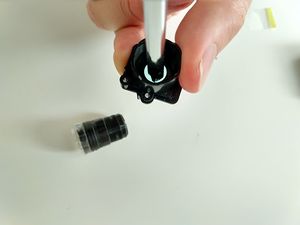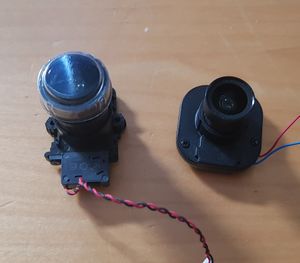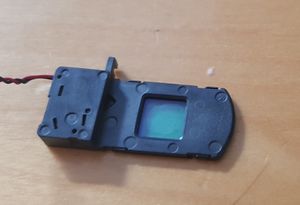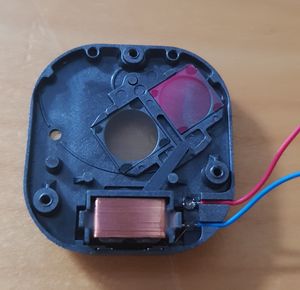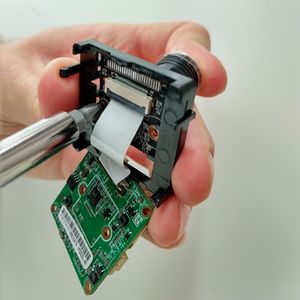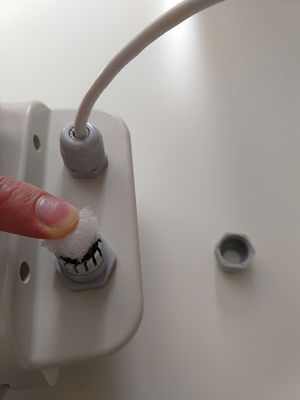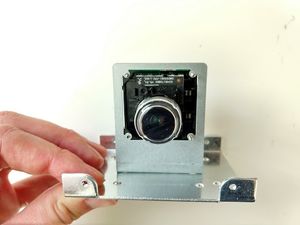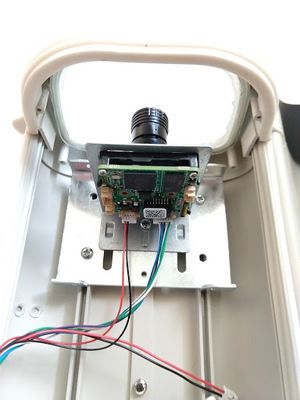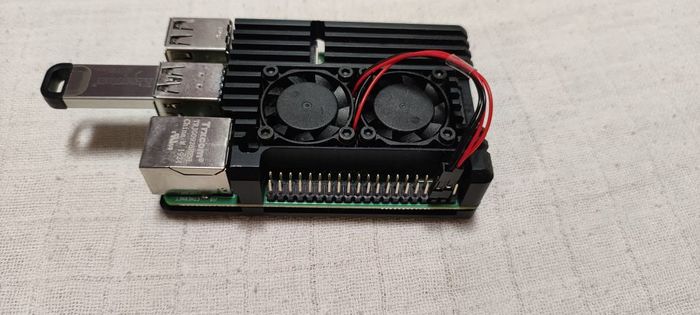Build the camera itself: Difference between revisions
RadimStano (talk | contribs) No edit summary |
mNo edit summary |
||
| (11 intermediate revisions by 2 users not shown) | |||
| Line 1: | Line 1: | ||
Most people think this section is the most fun. Here, you put all the pieces together. If you find something that is not particularly clear, let us know in the forums. | |||
= | <table><tr><td> | ||
== Prepare the lens == | |||
There are two types of lens holders - a holder with a single filter and a holder with an electronic filter drawer. | |||
[[File:Irblock.jpg|thumb|right|single filter: punch out the filter]] | [[File:Irblock.jpg|thumb|right|single filter: punch out the filter]] | ||
a. Remove the protective covers from the sensor and the lens. | |||
: '''IMPORTANT:''' Be careful not to touch the sensor after you remove the cover. | |||
The cameras come with an IR Block filter in the lens holder, but we do not use this filter. | |||
b. If you have a lens with a single filter like the one shown in the first image, unscrew the lens from the holder. | |||
''' | c. With a screwdriver, carefully push the filter out of the lens holder, as shown in the image on the right. | ||
: '''NOTE:''' If you push from the front, the filter may come out intact. If it shatters, make sure to remove all the shards. | |||
: Some lenses have an electronic day/night filter drawer and a small cable that plugs into the camera board. Two types of filter holders are shown here. | |||
[[File:lensholders2.jpg|thumb|right|Two sorts of lens holder with day/night filters]] | [[File:lensholders2.jpg|thumb|right|Two sorts of lens holder with day/night filters]] | ||
: '''WARNING:''' DO NOT try to directly punch out the filter. This action may jam the mechanism or leave shards of glass inside. | |||
d. If your holder is the type with a rectangular sliding drawer, remove the screw on the end and remove the drawer. | |||
Then remove the while filter glass entirely. | |||
[[File:slidedrawer.jpg|thumb|right|Sliding type: Remove the filter entirely]] | [[File:slidedrawer.jpg|thumb|right|Sliding type: Remove the filter entirely]] | ||
e. If your holder has a single drawer, remove the three small screws on the top and take off the cover. | |||
f. Remove the clear filter. | |||
: You can leave the reddish daylight filter. | |||
[[File:rotatingfilter.jpg|thumb|right|Rotating type: Remove just the clear filter]] | [[File:rotatingfilter.jpg|thumb|right|Rotating type: Remove just the clear filter]] | ||
g. Reassemble the filter holder, but do not connect the power cable to the camera. | |||
h. Turn the lens holder over to see two plastic nubbins on the underside of the lens holder. | |||
: Use wire cutters to snip off the nubbins. | |||
: '''NOTE:''' You must make the base completely flat. | |||
i. Screw the lens back into the lens holder. | |||
</td></tr></table> | </td></tr></table> | ||
<table><tr><td> | <table><tr><td> | ||
== Attach the lens to the camera == | |||
== | |||
[[File:lensattaching.jpg|thumb|right|Attaching the Lens]] | [[File:lensattaching.jpg|thumb|right|Attaching the Lens]] | ||
a. If you have an IMX291, carefully unclip the circuit board from the plastic holder, but do not detach the ribbon cable. (IMX307 is a single board) | |||
b. Use the supplied screws to attach the lens to the sensor. | |||
: '''IMPORTANT:''' Transistors and capacitors are very close to the area where a lens will be placed. When you install the lens onto an IMX307 module, be very careful. | |||
c. Replace the circuit board in the plastic holder. | |||
</td></tr></table> | </td></tr></table> | ||
<table><tr><td> | <table><tr><td> | ||
== Prepare the camera housing == | |||
= | |||
[[File:glands.jpg|thumb|right|Glands in Place]] | [[File:glands.jpg|thumb|right|Glands in Place]] | ||
a. Fit the small cable gland to the housing. | |||
b. Pass the loose ends of the camera PoE cable up through the housing, but do not tighten the cable. | |||
c. Slip the cap over the cable, then tighten the cable. | |||
b. Fit the large cable gland in the other opening, and push a piece of plastic packing foam into it. | |||
: '''TIP:''' Do not completely seal the opening. The idea is to prevent insects from getting in, but allow moisture out. | |||
: '''NOTE:''' We do not recommend that you put the entire cable inside the housing. The LEDs on it will create light pollution inside the housing. | |||
</td></tr></table> | </td></tr></table> | ||
<table><tr><td> | <table><tr><td> | ||
== | == Attach the camera == | ||
[[File:camerafitted.jpg|thumb|right|Camera In Mount]] | [[File:camerafitted.jpg|thumb|right|Camera In Mount]] | ||
At this time, you have the option to test the focus before you install the camera in the housing. If you do, skip this section for now and come back later. | |||
: '''TIP:''' If you install the camera in the housing at this point, there is no need to detach the cables and you will not have to reset the focus later. | |||
a. Connect the metal camera holder to the metal plate using (1) 6mm M3 screw. | |||
:''' NOTE:''' Be sure to match the orientation of the plate shown in the photo. | |||
b. Pass the lens through the square hole from the back of the metal holder, then use (3) 12 mm M2 screws to connect the camera board to the holder. | |||
: '''NOTE: ''' On some camera models, the writing on the camera board or the image of a stick man is UPSIDE DOWN when the orientation of the camera is correct. In this orientation, the sockets for power and networking are at the bottom rear of the camera board. | |||
To be sure you have the correct orientation, refer to the section titled, ''Testing and focus''. | |||
c. Remove the plastic cap from the lens. | |||
: '''TIP:''' Refer to the figure for the proper camera board orientation, so the video is not sideways or upside down. | |||
</td></tr></table> | </td></tr></table> | ||
<table><tr><td> | <table><tr><td> | ||
== Install the camera in the housing == | |||
== | |||
[[File:camerainhousing.jpg|thumb|right|Camera In Housing]] | [[File:camerainhousing.jpg|thumb|right|Camera In Housing]] | ||
a. Remove the plastic plate from inside the housing and discard it. | |||
b. Position the camera on its metal plate inside the housing, as close to the front glass as you can but do not come in contact with the glass. | |||
: '''NOTE:''' Ideally, the camera should be positioned 5mm or less from the glass. | |||
c. Orient the camera so you can see it from the rear, then attach the largest connector to the right-hand socket. | |||
: '''TIP:''' Usually, this connector has blue and green wires. | |||
d. Attach the power connector to the left-hand socket. This connector has several pins, but only the pins on the red and black wires are connected. | |||
e. The third connector (also with red and black wires) is used with a powered lens, which is not part of this installation. Tape the connector out of the way. | |||
f. After you secure the camera in position, tighten the cable glands. | |||
</td></tr></table> | </td></tr></table> | ||
<table><tr><td> | <table><tr><td> | ||
== Install cooling fans in hoousing of the Raspberry Pi 4 == | |||
In this step, you install two fans into the case. | |||
a. Remove the foil from the pads. | |||
b. Hold the fans in place, as sown in the figure, then screw the case together. | |||
c. Plug in the fan wires, as shown in the figure. | |||
[[File:Raspi4_in_case_small.jpg|700px]] | |||
</td></tr></table> | </td></tr></table> | ||
Now, the camera is ready. | |||
Next, you flash the RMS Linux image onto the SD card or USB key. [https://globalmeteornetwork.org/wiki/index.php?title=Build_%26_Install_%26_Setup_your_camera_-_The_complete_how-to Back to the signpost page.] | |||
Latest revision as of 07:54, 28 August 2025
Most people think this section is the most fun. Here, you put all the pieces together. If you find something that is not particularly clear, let us know in the forums.
Prepare the lensThere are two types of lens holders - a holder with a single filter and a holder with an electronic filter drawer. a. Remove the protective covers from the sensor and the lens.
The cameras come with an IR Block filter in the lens holder, but we do not use this filter. b. If you have a lens with a single filter like the one shown in the first image, unscrew the lens from the holder. c. With a screwdriver, carefully push the filter out of the lens holder, as shown in the image on the right.
d. If your holder is the type with a rectangular sliding drawer, remove the screw on the end and remove the drawer. Then remove the while filter glass entirely. e. If your holder has a single drawer, remove the three small screws on the top and take off the cover. f. Remove the clear filter.
g. Reassemble the filter holder, but do not connect the power cable to the camera. h. Turn the lens holder over to see two plastic nubbins on the underside of the lens holder.
i. Screw the lens back into the lens holder. |
Attach the lens to the cameraa. If you have an IMX291, carefully unclip the circuit board from the plastic holder, but do not detach the ribbon cable. (IMX307 is a single board) b. Use the supplied screws to attach the lens to the sensor.
c. Replace the circuit board in the plastic holder. |
Prepare the camera housinga. Fit the small cable gland to the housing. b. Pass the loose ends of the camera PoE cable up through the housing, but do not tighten the cable. c. Slip the cap over the cable, then tighten the cable. b. Fit the large cable gland in the other opening, and push a piece of plastic packing foam into it.
|
Attach the cameraAt this time, you have the option to test the focus before you install the camera in the housing. If you do, skip this section for now and come back later.
a. Connect the metal camera holder to the metal plate using (1) 6mm M3 screw.
b. Pass the lens through the square hole from the back of the metal holder, then use (3) 12 mm M2 screws to connect the camera board to the holder.
To be sure you have the correct orientation, refer to the section titled, Testing and focus. c. Remove the plastic cap from the lens.
|
Install the camera in the housinga. Remove the plastic plate from inside the housing and discard it. b. Position the camera on its metal plate inside the housing, as close to the front glass as you can but do not come in contact with the glass.
c. Orient the camera so you can see it from the rear, then attach the largest connector to the right-hand socket.
d. Attach the power connector to the left-hand socket. This connector has several pins, but only the pins on the red and black wires are connected. e. The third connector (also with red and black wires) is used with a powered lens, which is not part of this installation. Tape the connector out of the way. f. After you secure the camera in position, tighten the cable glands. |
Now, the camera is ready.
Next, you flash the RMS Linux image onto the SD card or USB key. Back to the signpost page.
